Dental bonding is a procedure in which a tooth-colored resin is applied and hardened
with a special light, ultimately "bonding" the material to the tooth to improve
a person's smile. Among the easiest and least expensive of cosmetic dental procedures,
bonding can repair chipped or cracked teeth, close gaps, change the shape of teeth,
or be used as a cosmetic alternative to silver amalgam fillings.
 Schedule Appointment
Schedule Appointment
Dental Bonding
Bonding Procedure: Because it does not involve dental laboratory work, tooth
bonding can usually be accomplished in a single visit to the dental office. Expect
the whole procedure to take 30 minutes to an hour. First, the surface of the tooth
to be bonded will be cleaned so it is plaque-free. The surface will then need to
be “etched” with an acidic gel that opens up tiny pores in the surface. After the
etching gel is rinsed off, the liquid composite resin in a well-matched shade is
painted on in a thin layer, filling these tiny pores to create a strong micromechanical
bond. A special curing light is used to harden this bonding material. Once the first
layer is cured, another layer is painted on and cured. Layers can continue to be
built up until the restoration has the necessary thickness. The bonding material
is then shaped to give it just the right form. Once the tooth not only looks great
but fits in perfectly with your bite, it will receive a final polishing.
For What Conditions Is Dental Bonding Considered?
Dental bonding is an option that can be considered:
- to repair chipped or cracked teeth
- to improve the appearance of discolored teeth
- to close spaces between teeth
- to make teeth look longer
- to change the shape of teeth
What are the Advantages and Disadvantages of Dental Bonding?
- Advantages: Bonding is among the easiest and least expensive of cosmetic dental procedures. Unlike veneers and crowns, which are customized tooth coverings
that must be manufactured in a laboratory, bonding usually can be done in one office
visit unless several teeth are involved. Another advantage, compared with veneers
and crowns, is that the least amount of tooth enamel is removed. Also, anesthesia
is usually not required.
- Disadvantages: Although the material used in dental bonding is somewhat stain resistant, it does not resist stains as well as crowns. Another disadvantage is
that the bonding materials do not last as long nor are as strong as other restorative
procedures, such as crowns, veneers, or fillings. Additionally, bonding materials
can chip and break off the tooth.
Because of some of the limitations of bonding, it may be best suited for
small cosmetic changes, for temporary correction of cosmetic defects, and for correction of teeth
in areas of very low bite pressure (for example, front teeth). Consult us at Gainesville
Dental Arts about the best cosmetic approach for your particular problem.
Care of dental bonding
- Simply follow good oral hygiene practices.
- Brush at least twice a day. It is good practice to brush after eating and before
bedtime.
- Floss at least once to twice a day.
- Rinse with fluoride rinse before bed. Swish the fluoride rinse vigorously in your
mouth for at least one minute. Do not swallow any of the rinse and do not eat or
drink anything for 30 minutes.
- Be careful about chewing toffees, gum, grainy rolls and tough food in this area.
- Visit us at Gainesville Dental Arts for professional check-ups and cleanings.